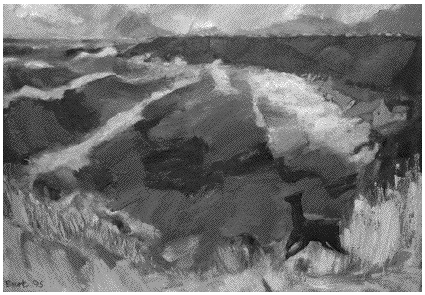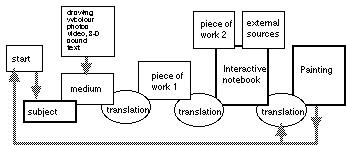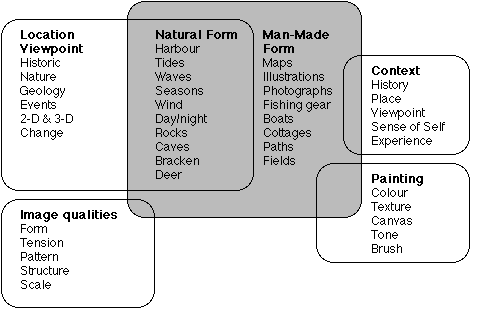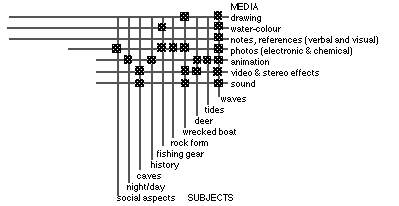 Iain Burt,
Iain Burt, Research Student, The Centre for Research in Art and Design, The Robert Gordon University, Aberdeen, Scotland.
Research Student, The Centre for Research in Art and Design Gray's School of Art,, The Robert Gordon University Aberdeen.
Abstract
Investigation of the concept of an electronic notebook, to enhance awareness of data and its context, and help in the 'making' process in Art and Design was carried out by the collating and comparing of textual, visual, time-based and aural data, in interactive form. The method helps structure viewpoints, and seems to support practice-led development of projects. Awareness of changing rhythms and atmosphere developed through drawing, recording and subsequently comparing elements and events. Simultaneously viewed on-screen, pairs of different images incorporating movement and change at different scales, as well as iteration of them, can reveal unexpected qualities, which centre the attention. The development, and translation of this type of overview, is realised in the form of 'awareness'. Director 4 was the application used for this.
Multimedia and Art and Design Research.
The research is part of work in progress towards a PhD. A painting in oil colour on canvas (working in a traditional technique) was the end-point of the sequence of research. (Plate 1) This developed from images and information, recorded in electronic media. Investigating relationships between static and moving images, displayed on-screen simultaneously, was part of the experiment. Incorporating 'painting in progress' images and further data into the 'notebook' characterised the cyclical nature of the process.
Outline of the Objectives of the Experiment
From the background of illustrative painting, design, photography and electronic media, methods to develop approaches to 'pre-canvas' co-ordination of ideas was sought. The oil painting (on 3' by 4') canvas was selected in this test to be the final medium. Newtonhill Bay, an inlet on the N.E. Coast of Scotland was chosen as the subject, it being convenient for frequent visits and offering many angles of study, in different weather conditions. An awareness of changing rhythms and atmosphere developed through drawing, recording and subsequently comparing elements and events. (The informal experiment was to consider the interaction of the elements shown in Diagram1.)
The illustrator Lynton Lamb (1953) wrote that the artist's workroom gave 'a proper sense of scale and detachment ' providing 'space for groups of miscellaneous objects stimulating the artist, as well as the disorder that accompanies living in unrestricted conditions'. Combination of electronic media may support working process too through juxtaposing, comparing and arranging elements, comments and sounds, drawings and sketches. (Drawings and water-colour sketches were put into electronic form by scanning.)
Rhythms and cycles of nature parallel musical harmony. Tidal movement may be compared with 'oblique motion'; when one musical part rises or falls, the other remains stationery. Stratified rock forms seem to echo the patterns of waves as they move across the bay, as well as echoing the lines of surface foam stretching behind the waves. A video sequence of the arrival of a fishing boat in the bay, in a rather heavy sea, and its near capsize on landing was made, a reminder of the ever present danger encountered.
Combining images on-screen
Lateral thinking in the use of visual computer tools; those suitable for manipulation of images as well as their production, enables researchers 'to explore, link develop and apply various software functions beyond their initially intended function.' (Gray, et al 1995) An image may carry within it much that can tolerate its breaking down yet remain recognisable as the original image, while at the same time the number of interpretations increased. One image can be selected and combined with another image to make a third, different from either, the original elements still being clearly visible. Simultaneously viewed on-screen, pairs of different images incorporating movement and change at different scales, as well as iteration of them, can reveal unexpected qualities, which centre the attention on awareness of time, and rhythm.The result of this seems to be an expanding awareness of the whole.
Video was taken of cave walls textured with a pink weed growth and dark red sea anemones. This space was of both the underwater world and the land, The tides created it's dual form. Drama centred on movement. An attempt was made to put down this type of experience in the interactive notebook entering it into electronic form. When recording elements for the 'notebook' the particular chosen medium influences how the subject is approached. Interactions are charted in Diagram 3.
Area of attention
The small field of view in which very little eye movement is required to encompass the subjects, (as in the case of a monitor), and when the collected and connected objects of attention are moving, as in the 'notebook', helps create a sense of control. (The line as it emerges from the drawing implement has a similar focused immediacy.) The small area that is totally central visually may be vital to the process of idea generation.
Plate 2 Three images from the electronic notebook, part of a video animation made to consider types of movement of objects of different sizes. Seeing these movements at the same time adds a dimension to the development process.
Virtualisation
Levy (1995) uses the concepts 'Virtualisation' and 'Actualisation' to describe the states that data may be in. Information within the computer data-base is virtualised, Levy suggests, in comparison to the presentation of it on-screen, when it is actualised. This compares with thought processes relevant to the experience of the artist in which a concept is restructured in a second medium (say using a photograph to produce detail in a painting): To translate an image from presentation in one medium to another involves mentally changing one actualised image into another.
The dynamic process that results in a new form may involve mental virtualisation followed by assimilation into a conscious and unconscious mental network before 'emerging' and being 'actualised' in the new form. Levy also sees Virtualisation as a 'shift in the centre of gravity' where the idea of a specific solution is re-considered as a general problem. (p1) In the development of relationships between images '...identity is no more linked to actual co-ordinates but to the special quality of the co-ordination process.' (p2) It is this process that the artist and designer may employ when using an electronic/interactive 'notebook'.
An Open System
A recorded image or sound may provide information on many different levels over and above that which appears along with the specific quality that led to the subject's selection. Bringing together elements may be a kind of holistic analysis in which the conscious element may be greatly aided by the raw impetus of the activity, amalgamating primary and realised awareness. (Rowan and Reason 1981 ) The opportunity to analyse a piece of action in detail, and then to combine the image with drawings and annotate it with comments and other linked forms, may help develop an intuitive sense of the holistic form.
Systems of interaction attempt to maintain a 'constant physical environment- by reducing the variability and disturbing effects of external stimulation' (Katz and Kahn) and that preserving the character of the system may be a feature of the process of integrating the new into the environment. Krech and Crutchfield (1948) put forward the idea that cognitive integration resists the absorption of new structures. However in open systems, there is movement within '..the direction of differentiation and elaboration. Diffuse global patterns are replaced by more specialised Junctions.' (Katz and Kahn) Likewise, as the multimedia notebook increases in volume, clusters of relationships develop around subject areas and ways of seeing this collection change.
Rowan and Reason (1981), examining awareness as a part of comprehension, divided awareness into two levels; Primary and Realised, in which communication at the former level is instant, instructive and brilliant but variable in force and accuracy (comparable to the moment when recording of the environment in photograph, video or sketch is occurring). At the Realised level, Rowan and Reason include awareness as part of a systematic memory search for understanding.
Limitations
Opportunity to have the interactive document to hand when the painting was in progress was not taken. Concentration on the activity of painting was chosen. Developed awareness of the subject, from using and constructing the 'interactive notebook' carried the painting work forward. A further experiment would be to use the media interface at the same time as carrying out the painting.
Results
Time-based interactions on-screen focused and developed awareness of the possibilities of the subject: Rate of change comparisons 'Historic' time in the form of changes in buildings, the tides, waves and wavelets are examples made interactive to compare and understand forms. Changing surface textures Looped sequences and focus-changing brought out the nature of the textures by simultaneous accessible images. Quality of movement Different qualities can be compared at the same time on screen. A mix of the running movement of a deer, bracken in the wind and the texture of the sea in three images verified this. Spatial awareness A red/green 3-D video pair provided insight into a quality of sea movement in which the rocks are spatially clear but waves, through multiple images suggest movement without the individual elements being defined stereoscopically. Events/Drama (l.) The appearance of a deer (subsequently incorporated in the painting) on the cliff top while video recording. (2.) The fishing boat incident. Panorama Views made from overlapping images, some which are looping video, increased the range of 'perspectives'.
Conclusion
The development, and translation of this type of overview, reaches it's realisation in the form of 'awareness'. With a painting as the result, movement as patterns tone and colour (Klee 1961) were brought together on canvas with the following factors in mind: (l.) The physical act of painting. (2.) The balance and wholeness of the composition. (3.) The dynamic presentation of subject matter. Further ways of using hypermedia methods as development tools, in contrast to use as an actual part of a visible, separate outcome, will emerge. This form of hypermedia investigative method in the hands of researchers, artists and designers may find the potential for, in particular, it's awareness-enhancing capacity, of value.
Bibliography
Gray, C. and Pirie, I. Artistic Research Procedure. Research at the Edge of Chaos? Proceedings. Design Interfaces Conference, Salford 1995
Katz, D. and Kahn, R.L. Common Characteristics of Open Systems in Systems Thinking, ed. Emery, F.E. Penguin 1969
Levy, P. Welcome to Virtuality Proceedings, Digital Creativity 1st. Conf. Computers in Art and Design Education, Brighton 1995
Klee, P. The Thinking Eye Lund Humphries 1961
Kretch, D. and Crutchfield, R. Theory and Problems of Social Psychology , McGraw Hill 1948
Lamb, L. Preparation for Painting Penguin 1954
Rowan, J. and Reason, P. On Making Sense in Human Enquiry. ed. Rowan, J. and Reason, P John Wiley 1981
DIAGRAMS
Diagram 1 The overlap of shapes represents a decision-making or interpretative activity. The feedback line shows how further interaction occurs.
Diagram 2 The elements of the interaction grouped here represent the content of Diagram 1
Diagram 3 Relationships between media and subject matter are shown along the co-ordinates. Elements represented by a square are part of the electronic `notebook' recording process.
For more SYNDICATE SPEAKERS For other SYNDICATES |




